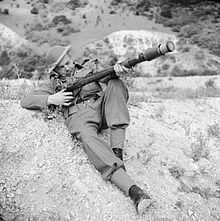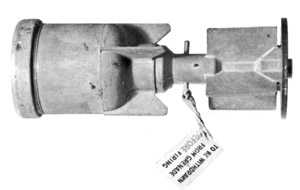No. 68 AT Grenade
| Grenade, Rifle No. 68 /AT | |
|---|---|
|
The Mark 1 No. 68 Rifle grenade, shown with the nose facing left | |
| Type | Anti-tank rifle grenade |
| Place of origin |
|
| Service history | |
| In service | 1940–1945 |
| Production history | |
| Designed | 1940 |
| Variants | Mk 1 to Mk VI |
| Specifications | |
| Weight | 894 grams (31.5 oz) |
|
| |
| Filling | Lyddite, Pentolite or RDX/Beeswax |
| Filling weight | 156 grams (5.5 oz) |
Detonation mechanism | Impact |
The Grenade, Rifle No. 68 /AT was a British anti-tank rifle grenade used during World War II.
Design

The No. 68 was an early form of shaped charge grenade, and has some claim to have been the first High Explosive, Anti Tank (HEAT) device in use. The design of the warhead was simple and was capable of penetrating 52mm (2 inches) of armour in 1940.[1]
The fuze of the grenade was armed by removing a pin in the tail which prevented the firing pin from flying forward. The grenade was launched from a rifle cup. The simple fins gave it some stability in the air and, provided the grenade hit the target at the proper angle (90 degrees), the charge would be effective. Detonation occurred on impact, when a striker in the tail of the grenade overcame the resistance of a creep spring and was thrown forward into a stab detonator.
References
- ↑ R F Eather, BSc & N Griffithe, OBE MSc - Some Historical Aspects of the Development of Shaped Charges - Ministry of Defence, Royal Armament Research and Development Establishment - 1984 - page 6 - AD-A144 098
- Ian V. Hogg - The Encyclopedia of Infantry Weapons of World War II - Arms & Armour Press - 1977 - ISBN 0-85368-281-X
External links
- The Home Guard Pocket Manual, by Capt. A. Southworth, M.B.E., p49-50: description of the No. 68 AT Grenade, use and diagram.
| ||||||||||||||
